Trends of Key Greenhouse Gases as Measured in 2009–2022 at the FTIR Station of St. Petersburg State University
Abstract
:1. Introduction
- -
- the adaptation of retrieval strategies for deriving the total columns of CO2, CH4 and N2O by FTIR spectra of direct solar radiation has been carried out. During this step, special attention was paid to the specific features of the SPbU FTIR system and the weather/climatic conditions of the STP station;
- -
- the archives of FTIR spectra recorded at the STP station within the period 2009–2022 were processed, and these activities resulted in obtaining the fourteen-year series of TCs of key greenhouse gases;
- -
- to evaluate the long-term trend of CO2, CH4 and N2O, an original approach for approximation of the TCs time series has been proposed and implemented. It is based on the Lomb–Scargle harmonic analysis of uneven time series, a cross-validation technique for analyzing the optimality of the fitting model and statistical bootstrapping for evaluating the reliability of the obtained long-term trends
- -
- Introduction;
- -
- Section 1: general information on the SPbU atmospheric monitoring station including geographical, climate and weather features;
- -
- Section 2: a description of the FTIR system installed at the STP station, and an overview of the inverse methods and retrieval strategies used to derive the total columns/profiles of the target gases;
- -
- Section 3: Results and Discussion, including the characterization of the retrieval results and a time series analysis aimed at identifying long-term trends for LLGHG total columns;
- -
- Conclusions.
General Information about the SPbU Atmospheric Monitoring Station
2. Instruments and Methods
2.1. SPbU FTIR System
2.2. Inverse Methods and Retrieval Strategies
- -
- site-specific a priori VMR profiles of the retrieved and interfering species;
- -
- site-specific a priori covariance matrixes (Sa) for the retrieved and interfering species (constructed using WACCM v.6 data on variability of VMR profiles).
3. Results and Discussion
3.1. Characterizing Retrieval Results: Spectral Fitting, Uncertainty Analysis and Averaging Kernels
- -
- the RMS discrepancy between the observed and simulated spectra as a measure of the quality of spectral fitting (see column 3 of Table 4). The typical examples of spectral fitting for corresponding spectral intervals used in the CH4, CO2, and N2O retrievals are given in Figure 5, Figure 6 and Figure 7, respectively;
- -
- the uncertainty (error) budget including the analysis of random, systematic, and smoothing uncertainties (see columns 7–9 of Table 4);
- -
- the averaging kernels (AVKs) for VMR, the “sensitivity” of the retrievals to the measurements [55] (Figure 8, Figure 9 and Figure 10), and the value of degrees of freedom for the signal (DOFS; see columns 5–6 of Table 4), which characterize the vertical sensitivity of the retrieval. The sensitivity at altitude level i is calculated as the sum of the elements of the corresponding averaging kernel ΣkAVKik;
- -
- -
- the systematic error which originates from the systematic uncertainties of the following forward model/input parameters: spectroscopy (line intensity, line broadening by pressure and temperature, solar line intensity), sun zenith angle (SZA), curvature of the spectrum baseline, phase, optical path difference (OPD), field of view (FOV). The systematic error budget is mainly defined by uncertainties in the spectroscopic information, i.e., line intensities and broadening factors [40];
- -
- random error, which includes measurement error (due to measurement noise), random uncertainties of forward model/input parameters, uncertainties of the parameters of the retrieval algorithm, interference error (due to retrieved interfering gases) and smoothing error. The dominant inputs into random uncertainty are as follows: measurement noise, baseline uncertainty, and uncertainties in the input temperature profile [40,42];
- -
- the smoothing error, which is assumed to be random in our study (with no systematic component), reflects the uncertainty due to the limited vertical resolution of the FTIR observations.
3.2. Time Series Analysis: Long-Term Trends of GHG TCs
- Harmonic analysis of the time series of LLGHG TCs. For this purpose, time series were previously detrended using the simple linear regression. After detrending, the Lomb–Scargle method, which is a modification of Fourier analysis for uneven time series, was applied [57,58,59]. The outcome is a set of n periods/frequencies having peaks (maxima) of spectral density in periodogram.
- Estimation of an optimal set of N harmonic functions (from the whole set n) which provides the best approximation. To achieve this goal, we evaluated the performance of a model FTC(t) on unseen data (cross-validation technique). It involves dividing the available time series (TC) into multiple subsets, using one of these subsets as a validation set, and training the model on the remaining subsets (https://www.geeksforgeeks.org/cross-validation-machine-learning/, accessed on 23 March 2024). We made this analysis multiple times, including i most significant harmonic functions at each step (starting from i = 1 and ending with i = n). For each step we determined the RMS value of the discrepancy between validation set and model function FTC(t). The optimal number N provides the minimum value of the RMS discrepancy between the model and the validation set. Approximations FTC(t) for 2009–2022, which were constructed with the optimal numbers N, are presented in Figure 11, Figure 12 and Figure 13 by solid lines.
- Evaluation of the mean value of a trend (coefficient b) and its confidence intervals/uncertainty. For this purpose, the bootstrapping approach was implemented [54,60]. To characterize the distribution function for trend (allowing us to estimate the mean slope b and 1σ uncertainty as distribution halfwidth), we used a bootstrap population of ~400 (a further increase of this number does not lead to any noticeable changes in the results).
| Target Gas | Mean Trend | ||||||||
|---|---|---|---|---|---|---|---|---|---|
| 2009–2022 | 2009–2019 | 2012–2021 | 2013–2019 | ||||||
| FTIR TC, FTIR XGAS | FTIR TC | FTIR TC (IO) | FTIR TC (TAO) | EMAC TCFTIR_AVK | FTIR XGAS | Global In Situ VMR (GAW) | FTIR XGAS | In Situ VMR | |
| CH4, % yr−1 ppb yr−1 | 0.46 ± 0.02 8.8 ± 0.4 | 0.44 ± 0.04 | 0.43 ± 0.03 | 0.41 ± 0.03 | 0.16 ± 0.04 | 0.47 ± 0.05 8.5 ± 1.0 | 0.51 9.2 | 0.52 ± 0.04 9.4 ± 0.7 | 0.49 8.6 ± 0.8 |
| CO2, % yr−1 ppm yr−1 | 0.56 ± 0.01, 2.28 ± 0.05 | 0.58 ± 0.02 | - | - | 0.52 ± 0.02 | 0.61 ± 0.02 2.52 ± 0.07 | 0.61 2.46 | 0.61 ± 0.04 2.5 ± 0.1 | 0.60 2.42 ± 0.1 |
| N2O, % yr−1 ppb yr−1 | 0.28 ± 0.01 0.82 ± 0.03 | 0.26 ± 0.02 | 0.31 ± 0.03 | - | 0.20 ± 0.02 | 0.30 ± 0.03 0.91 ± 0.08 | 0.31 1.01 | 0.26 ± 0.04 0.8 ± 0.1 | - |
4. Summary and Conclusions
- The retrieval strategies from IRWG NDACC for deriving the CO2, CH4 and N2O total columns in the atmosphere from high-resolution FTIR spectra of direct solar radiation [39,43,44] have been adapted to the observational conditions at the STP station. The application of these adapted strategies resulted in the LLGHG TC retrievals with random and systematic uncertainties, on average, equal to 2.2% and 3.4% for CO2, 1.5% and 3.6% for CH4, 1.2% and 2.6% for N2O, respectively. The average values of the smoothing uncertainty are of 0.5%, 0.5%, and 0.2% for CO2, CH4, and N2O, respectively.
- The average values of the CO2, CH4, and N2O TCs for 2009–2022 observed at the STP site constitute 8.79 × 1021 molec/cm2, 3.885 × 1019 molec/cm2 and 6.59 × 1018 molec/cm2, respectively. The average values of XGAS are equal to ~409 ppm for CO2, ~1.807 ppm for CH4, and ~0.3071 ppm for N2O.
- An evaluation of the TC and XGAS trends for LLGHGs was carried out using the combined approach for time series analysis. This approach included the Lomb–Scargle method for harmonic analysis, the least squares method for data fitting, the cross-validation algorithm to determine the optimal number of harmonic functions, and the bootstrapping technique to estimate the confidence intervals of trends. The fourteen-year (2009–2022) trends of TCs and XGAS estimated using such a combined approach are as follows: (0.56 ± 0.01) % yr−1 and (2.28 ± 0.05) ppm yr−1 for CO2; (0.46 ± 0.02) % yr−1 and (8.8 ± 0.4) ppb yr−1 for CH4; (0.28 ± 0.01) % yr−1 and (0.82 ± 0.03) ppb yr−1 for N2O;
- The TCs and XGAS trends of LLGHGs observed at the STP site are in general agreement with the results of in situ VMR monitoring carried out at the same geographical location in the period 2013–2019 (Foka et al., in print), and with the independent estimates of global VMR growth rates obtained by the GAW network in the period 2012–2021 (WMO, 2022) and the NOAA Global Monitoring Laboratory in the period 2009–2022 [10,11,66]. There is reasonable agreement between the CH4 and N2O TC trends for 2009–2019 at the STP site, at Izaña Observatory [40], and also at the University of Toronto Atmospheric Observatory [61].
- A comparison of the EMAC model results with the FTIR data shows that for N2O and CO2, the EMAC and FTIR trends of TC agree within 3σ. The largest difference in the experimental and model TC trends, amounting to 0.28% yr−1 and exceeding the 3σ limit, was obtained for CH4.
Author Contributions
Funding
Data Availability Statement
Acknowledgments
Conflicts of Interest
References
- WMO Greenhouse Gas Bulletin, No. 18, 26 October 2022, ISSN 2078-0796. Available online: https://library.wmo.int/idurl/4/58743 (accessed on 23 March 2024).
- Montzka, S.A. The NOAA Annual Greenhouse Gas Index (AGGI). National Oceanic and Atmospheric Administration (NOAA) Earth System Research Laboratories Global Monitoring Laboratory. 2022. Available online: http://www.esrl.noaa.gov/gmd/aggi/aggi.html (accessed on 23 March 2024).
- IPCC. Climate Change 2021: The Physical Science Basis. Contribution of Working Group I to the Sixth Assessment Report of the Intergovernmental Panel on Climate Change; Masson-Delmotte, V., Zhai, P., Pirani, A., Connors, S.L., Péan, C., Berger, S., Caud, N., Chen, Y., Goldfarb, L., Gomis, M.I., et al., Eds.; Cambridge University Press: Cambridge, UK; New York, NY, USA, 2021; 2391p. [Google Scholar]
- Dlugokencky, E.J.; Houweling, S.; Bruhwiler, L.; Masarie, K.A.; Lang, P.M.; Miller, J.B.; Tans, P.P. Atmospheric methane levels off: Temporary pause or a new steady-state. Geophys. Res. Lett. 2003, 30, 1992. [Google Scholar] [CrossRef]
- Kirschke, S.; Bousquet, P.; Ciais, P.; Saunois, M.; Canadell, J.G.; Dlugokencky, E.J.; Bergamaschi, P.; Bergmann, D.; Blake, D.R.; Bruhwiler, L.; et al. Three decades of global methane sources and sinks. Nat. Geosci. 2013, 6, 813–823. [Google Scholar] [CrossRef]
- Prather, M.J.; Hsu, J.; DeLuca, N.M.; Jackman, C.H.; Oman, L.D.; Douglass, A.R.; Fleming, E.L.; Strahan, S.E.; Steenrod, S.D.; Søvde, O.A.; et al. Measuring and modeling the lifetime of nitrous oxide including its variability. J. Geophys. Res. Atmos. 2015, 120, 5693–5705. [Google Scholar] [CrossRef]
- Patra, P.K.; Crisp, D.; Kaiser, J.W.; Wunch, D.; Saeki, T.; Ichii, K.; Sekiya, T.; Wennberg, P.O.; Feist, D.G.; Pollard, D.F.; et al. The Orbiting Carbon Observatory (OCO-2) tracks 2–3 peta-gram increase in carbon release to the atmosphere during the 2014–2016 El Niño. Nat. Sci. Rep. 2017, 7, 13567. [Google Scholar] [CrossRef]
- Schaefer, H. On the causes and consequences of recent trends in atmospheric methane. Curr. Clim. Chang. Rep. 2019, 5, 259–274. [Google Scholar] [CrossRef]
- WMO Greenhouse Gas Bulletin, No. 17, 25 October 2021, ISSN 2078-0796. Available online: https://library.wmo.int/idurl/4/58705 (accessed on 23 March 2024).
- Tans, P. NOAA/GML. Available online: https://gml.noaa.gov/ccgg/trends/ (accessed on 19 October 2023).
- Keeling, R. Scripps Institution of Oceanography. Available online: https://scrippsco2.ucsd.edu/ (accessed on 19 October 2023).
- Liang, A.; Gong, W.; Han, G.; Xiang, C. Comparison of Satellite-Observed XCO2 from GOSAT, OCO-2, and Ground-Based TCCON. Remote Sens. 2017, 9, 1033. [Google Scholar] [CrossRef]
- Siddans, R.; Knappett, D.; Kerridge, B.; Waterfall, A.; Hurley, J.; Latter, B.; Boesch, H.; Parker, R. Global height-resolved methane retrievals from the Infrared Atmospheric Sounding Interferometer (IASI) on MetOp. Atmos. Meas. Tech. 2017, 10, 4135–4164. [Google Scholar] [CrossRef]
- Alberti, C.; Tu, Q.; Hase, F.; Makarova, M.V.; Gribanov, K.; Foka, S.C.; Zakharov, V.; Blumenstock, T.; Buchwitz, M.; Diekmann, C.; et al. Investigation of spaceborne trace gas products over St Petersburg and Yekaterinburg, Russia, by using COllaborative Column Carbon Observing Network (COCCON) observations. Atmos. Meas. Tech. 2022, 15, 2199–2229. [Google Scholar] [CrossRef]
- Sha, M.K.; Langerock, B.; Blavier, J.-F.L.; Blumenstock, T.; Borsdorff, T.; Buschmann, M.; Dehn, A.; De Mazière, M.; Deutscher, N.M.; Feist, D.G.; et al. Validation of methane and carbon monoxide from Sentinel-5 Precursor using TCCON and NDACC-IRWG stations. Atmos. Meas. Tech. 2021, 14, 6249–6304. [Google Scholar] [CrossRef]
- EPA. Understanding Global Warming Potentials. Available online: https://www.epa.gov/ghgemissions/understanding-global-warming-potentials (accessed on 11 September 2023).
- EPA. Overview of Greenhouse Gases. Available online: https://www.epa.gov/ghgemissions/overview-greenhouse-gases#CO2-references (accessed on 11 September 2023).
- COPERNICUS. Greenhouse Gases. Available online: https://climate.copernicus.eu/climate-indicators/greenhouse-gases (accessed on 11 September 2023).
- Andrews, J.E.; Brimblecombe, P.; Jickells, T.D.; Liss, P.S.; Reid, B. An Introduction to Environmental Chemistry; Blackwell Science: London, UK, 1996. [Google Scholar]
- De Mazière, M.; Thompson, A.M.; Kurylo, M.J.; Wild, J.D.; Bernhard, G.; Blumenstock, T.; Braathen, G.O.; Hannigan, J.W.; Lambert, J.C.; Leblanc, T.; et al. The Network for the Detection of Atmospheric Composition Change (NDACC): History, status and perspectives. Atmos. Chem. Phys. 2018, 18, 4935–4964. [Google Scholar] [CrossRef]
- Lutsch, E.; Strong, K.; Jones DB, A.; Blumenstock, T.; Conway, S.; Fisher, J.A.; Hannigan, J.W.; Hase, F.; Kasai, Y.; Mahieu, E.; et al. Detection and attribution of wildfire pollution in the Arctic and northern midlatitudes using a network of Fourier-transform infrared spectrometers and GEOS-Chem. Atmos. Chem. Phys. 2020, 20, 12813–12851. [Google Scholar] [CrossRef]
- Ionov, D.V.; Poberovskii, A.V.; Ionov, V.V. Spectroscopic Remote Sensing of NO2 Levels in Urban Air. J. Appl. Spectrosc. 2017, 84, 109–113. [Google Scholar] [CrossRef]
- Foka, S.C.; Makarova, M.V.; Poberovskii, A.V.; Timofeev, Y.M. Temporal variations of CO2, CH4 и CO concentrations in the suburb of Saint-Petersburg (Peterhof). Atmos. Ocean. Opt. 2019, 32, 860–866. (In Russian) [Google Scholar] [CrossRef]
- Ionov, D.V.; Poberovskii, A.V. Variability of Nitrogen Oxides in the Atmospheric Surface Layer near Saint Petersburg. Russ. Meteorol. Hydrol. 2020, 45, 720–726. [Google Scholar] [CrossRef]
- Makarova, M.V.; Alberti, C.; Ionov, D.V.; Hase, F.; Foka, S.C.; Blumenstock, T.; Warneke, T.; Virolainen, Y.A.; Kostsov, V.S.; Frey, M.; et al. Emission Monitoring Mobile Experiment (EMME): An overview and first results of the St. Petersburg megacity campaign 2019. Atmos. Meas. Tech. 2021, 14, 1047–1073. [Google Scholar] [CrossRef]
- Makarova, M.V.; Kirner, O.; Timofeev, Y.M.; Poberovskii, A.V.; Imkhasin, K.K.; Osipov, S.I.; Makarov, B.K. Analysis of methane total column variations in the atmosphere near St. Petersburg using ground-based measurements and simulations. Izv. Atmos. Ocean. Phys. 2015, 51, 177–185. [Google Scholar] [CrossRef]
- Makarova, M.V.; Kirner, O.; Timofeev, Y.M.; Poberovskii, A.V.; Imkhasin, K.K.; Osipov, S.I.; Makarov, B.K. Annual cycle and long-term trend of the methane total column in the atmosphere over the St. Petersburg region. Izv. Atmos. Ocean. Phys. 2015, 51, 431–438. [Google Scholar] [CrossRef]
- Makarova, M.V.; Poberovskii, A.V.; Polyakov, A.V.; Visheratin, K.N. Time variability of the total methane content in the atmosphere over the vicinity of St. Petersburg. Izv. Atmos. Ocean. Phys. 2009, 45, 723–730. [Google Scholar] [CrossRef]
- Makarova, M.V.; Poberovskii, A.V.; Osipov, S.I. Time variations of the total CO content in the atmosphere near St. Petersburg. Izv. Atmos. Ocean. Phys. 2011, 47, 739–746. [Google Scholar] [CrossRef]
- Poberovskii, A.V. High-resolution ground measurements of the IR spectra of solar radiation. Atmos. Ocean. Opt. 2010, 23, 161–163. [Google Scholar] [CrossRef]
- Hase, F.; Blumenstock, T.; Paton-Walsh, C. Analysis of the instrumental line shape of high-resolution Fourier transform IR spectrometers with gas cell measurements and new retrieval software. Appl. Opt. 1999, 38, 3417–3422. [Google Scholar] [CrossRef]
- Tikhonov, A. On the solution of incorrectly stated problems and a method of regularization. Dokl. Acad. Nauk SSSR 1963, 151, 501–504. [Google Scholar]
- Rodgers, C.D. Retrieval of atmospheric temperature and composition from remote measurements of thermal radiation. Rev. Geophys. 1976, 14, 609–624. [Google Scholar] [CrossRef]
- Rodgers, C.D. Inverse Methods for Atmospheric Sounding: Theory and Practice, Series on Atmospheric, Oceanic and Planetary Physics; World Scientific Publishing Co.: Singapore, 2000; Volume 2, p. 256. ISBN 978-981-02-2740-1. [Google Scholar] [CrossRef]
- Pougatchev, N.S.; Connor, B.J.; Rinsland, C.P. Infrared measurements of the ozone vertical distribution above Kitt Peak. J. Geophys. Res. 1995, 100, 16689–16697. [Google Scholar] [CrossRef]
- Rinsland, C.P.; Jones, N.B.; Connor, B.J.; Logan, J.A.; Pougatchev NSGoldman, A.; Murcray, F.J.; Stephen, T.M.; Pine, A.S.; Zander, R.; Mahieu, E.; et al. Northern and southern hemisphere ground-based infrared spectroscopic measurements of tropospheric carbon monoxide and ethane. J. Geophys. Res. 1998, 103, 28197–28217. [Google Scholar] [CrossRef]
- Hase, F.; Hannigan, J.W.; Coffey, M.T.; Goldman, A.; Höpfner, M.; Jones, N.B.; Rinsland, C.P.; Wood, S.W. Intercomparison of retrieval codes used for the analysis of high-resolution, ground-based FTIR measurements. J. Quant. Spectros. Radiat. Transf. 2004, 87, 25–52. [Google Scholar] [CrossRef]
- Hase, F.; Demoulin, P.; Sauval, A.J.; Toon, G.C.; Bernath, P.F.; Goldman, A.; Hannigan, J.W.; Rinsland, C.P. An empirical line-by-line model for the infrared solar transmittance spectrum from 700 to 5000 cm−1. J. Quant. Spectros. Radiat. Transf. 2006, 102, 450–463. [Google Scholar] [CrossRef]
- Sussmann, R.; Forster, F.; Rettinger, M.; Jones, N. Strategy for high-accuracy-and-precision retrieval of atmospheric methane from the mid-infrared FTIR network. Atmos. Meas. Tech. 2011, 4, 1943–1964. [Google Scholar] [CrossRef]
- García, O.E.; Schneider, M.; Sepúlveda, E.; Hase, F.; Blumenstock, T.; Cuevas, E.; Ramos, R.; Gross, J.; Barthlott, S.; Röhling, A.N.; et al. Twenty years of ground-based NDACC FTIR spectrometry at Izaña Observatory—Overview and long-term comparison to other techniques. Atmos. Chem. Phys. 2021, 21, 15519–15554. [Google Scholar] [CrossRef]
- Steck, T. Methods for determining regularization for atmospheric retrieval problems. Appl. Opt. 2002, 41, 1788–1797. [Google Scholar] [CrossRef]
- Vigouroux, C.; Bauer Aquino, C.A.; Bauwens, M.; Becker, C.; Blumenstock, T.; De Mazière, M.; García, O.; Grutter, M.; Guarin, C.; Hannigan, J.; et al. NDACC harmonized formaldehyde time series from 21 FTIR stations covering a wide range of column abundances. Atmos. Meas. Tech. 2018, 11, 5049–5073. [Google Scholar] [CrossRef]
- IRWG, Uniform Retrieval Parameter Summary. 2022. Available online: https://www.acom.ucar.edu/irwg/IRWG_Uniform_RP_Summary-3.pdf (accessed on 24 October 2023).
- Barthlott, S.; Schneider, M.; Hase, F.; Wiegele, A.; Christner, E.; González, Y.; Blumenstock, T.; Dohe, S.; García, O.E.; Sepúlveda, E.; et al. Using XCO2 retrievals for assessing the long-term consistency of NDACC/FTIR data sets. Atmos. Meas. Tech. 2015, 8, 1555–1573. [Google Scholar] [CrossRef]
- Garcia, R.R.; Marsh, D.R.; Kinnison, D.E.; Boville, B.A.; Sassi, F. Simulation of secular trends in the middle atmosphere, 1950-2003. J. Geophys. Res. 2007, 112, D09301. [Google Scholar] [CrossRef]
- Rothman, L.S.; Jacquemart, D.; Barbe, A.; Benner, D.C.; Birk, M.; Brown, L.R.; Carleer, M.R.; Chackerian, C.; Chance, K.; Coudert, L.H.; et al. The HITRAN 2004 molecular spectroscopic database. J. Quant. Spectrosc. Radiat. Transf. 2005, 96, 139–204. [Google Scholar] [CrossRef]
- Rothman, L.S.; Gordon, I.E.; Barbe, A.; Benner, D.C.; Bernath, P.F.; Birk, M.; Boudon, V.; Brown, L.R.; Campargue, A.; Champion, J.-P.; et al. The Hitran 2008 molecular spectroscopic database. J. Quant. Spectrosc. Radiat. Transf. 2009, 110, 533–572. [Google Scholar] [CrossRef]
- Rothman, L.S.; Gordon, I.E.; Babikov, Y.; Barbe, A.; Benner, D.C.; Bernath, P.F.; Birk, M.; Bizzocchi, L.; Boudon, V.; Brown, L.R.; et al. The HITRAN2012 molecular spectroscopic database. J. Quant. Spectrosc. Radiat. Transf. 2013, 130, 4–50. [Google Scholar] [CrossRef]
- Gordon, I.E.; Rothman, L.S.; Hill, C.; Kochanov, R.V.; Tan, Y.; Bernath, P.F.; Birk, M.; Boudon, V.; Campargue, A.; Chance, K.V.; et al. The HITRAN2016 molecular spectroscopic database. J. Quant. Spectrosc. Radiat. Transf. 2017, 203, 3–69. [Google Scholar] [CrossRef]
- Toon, G.C.; Blavier, J.F.; Sung, K.; Rothman, L.S.; Gordon, I.E. HITRAN spectroscopy evaluation using solar occultation FTIR spectra. J. Quant. Spectrosc. Radiat. Transf. 2016, 182, 324–336. [Google Scholar] [CrossRef]
- Hase, F.; Wallace, L.; McLeod, S.D.; Harrison, J.J.; Bernath, P.F. The ACE-FTS atlas of the infrared solar spectrum. J. Quant. Spectros. Radiat. Transf. 2010, 111, 521–528. [Google Scholar] [CrossRef]
- Vigouroux, C.; Stavrakou, T.; Whaley, C.; Dils, B.; Duflot, V.; Hermans, C.; Kumps, N.; Metzger, J.-M.; Scolas, F.; Vanhaelewyn, G.; et al. FTIR time-series of biomass burning products (HCN, C2H6, C2H2, CH3OH, and HCOOH) at Reunion Island (21° S, 55° E) and comparisons with model data. Atmos. Chem. Phys. 2012, 12, 10367–10385. [Google Scholar] [CrossRef]
- Viatte, C.; Strong, K.; Walker, K.A.; Drummond, J.R. Five years of CO, HCN, C2H6, C2H2, CH3OH, HCOOH and H2CO total columns measured in the Canadian high Arctic. Atmos. Meas. Tech. 2014, 7, 1547–1570. [Google Scholar] [CrossRef]
- Hannigan, J.W.; Ortega, I.; Shams, S.B.; Blumenstock, T.; Campbell, J.E.; Conway, S.; Flood, V.; Garcia, O.; Griffith, D.; Grutter, M.; et al. Global atmospheric OCS trend analysis from 22 NDACC stations. J. Geophys. Res. Atmos. 2022, 127, e2021JD035764. [Google Scholar] [CrossRef]
- Vigouroux, C.; De Mazière, M.; Demoulin, P.; Servais, C.; Hase, F.; Blumenstock, T.; Kramer, I.; Schneider, M.; Mellqvist, J.; Strandberg, A.; et al. Evaluation of tropospheric and stratospheric ozone trends over Western Europe from ground-based FTIR network observations. Atmos. Chem. Phys. 2008, 8, 6865–6886. [Google Scholar] [CrossRef]
- Deutscher, N.M.; Griffith, D.W.T.; Bryant, G.W.; Wennberg, P.O.; Toon, G.C.; Washenfelder, R.A.; Keppel-Aleks, G.; Wunch, D.; Yavin, Y.; Allen, N.T.; et al. Total column CO2 measurements at Darwin, Australia—Site de-scription and calibration against in situ aircraft profiles. Atmos. Meas. Tech. 2010, 3, 947–958. [Google Scholar] [CrossRef]
- Lomb, N.R. Least-squares frequency analysis of unequally spaced data. Astrophys. Space Sci. 1976, 39, 447–462. [Google Scholar] [CrossRef]
- VanderPlas, J.T. Understanding the Lomb–Scargle Periodogram. Astrophys. J. Suppl. Ser. 2018, 236, 16. [Google Scholar] [CrossRef]
- The Astropy Collaboration. The Astropy Project: Sustaining and Growing a Community-oriented Open-source Project and the Latest Major Release(v5.0) of the Core Package. Astrophys. J. 2022, 935, 20. [Google Scholar] [CrossRef]
- Efron, B.; Tibshirani, R.J. An Introduction to the Bootstrap; CRC Press: Boca Raton, FL, USA, 1994. [Google Scholar]
- Yamanouchi, S.; Strong, K.; Colebatch, O.; Conway, S.; Jones DB, A.; Lutsch, E.; Roche, S. Atmospheric trace gas trends obtained from FTIR column measurements in Toronto, Canada from 2002–2019. Environ. Res. Commun. 2021, 3, 051002. [Google Scholar] [CrossRef]
- Jöckel, P.; Tost, H.; Pozzer, A.; Bruhl, C.; Buchholz, J.; Ganzeveld, L.; Hoor, P.; Kerkweg, A.; Lawrence, M.G.; Sander, R.; et al. The atmospheric chemistry general circulation model ECHAM5/MESSy1: Consistent simulation of ozone from the surface to the mesosphere. Atmos. Chem. Phys. 2006, 6, 5067–5104. [Google Scholar] [CrossRef]
- Kirner, O.; Ruhnke, R.; Buchholz-Dietsch, J.; Jöckel, P.; Brühl, C.; Steil, B. Simulation of polar stratospheric clouds in the chemistry-climate-model EMAC via the submodel PSC. Geosci. Model Dev. 2011, 4, 169–182. [Google Scholar] [CrossRef]
- Rodgers, C.D.; Connor, B.J. Intercomparison of remotesounding instruments. J. Geophys. Res. 2003, 108, 4116–4129. [Google Scholar] [CrossRef]
- Foka, S.C.; Makarova, M.V.; Poberovsky, A.V.; Ionov, D.V.; Abakumov, E.V. Analysis of mixing ratios of carbon-containing gases at the atmospheric monitoring station of St. Petersburg State University. Atmos. Ocean. Opt. 2023, 36, 934–941. (In Russian) [Google Scholar] [CrossRef]
- Lan, X.; Thoning, K.W.; Dlugokencky, E.J. Trends in globally-averaged CH4, N2O, and SF6 determined from NOAA Global Monitoring Laboratory measurements. Version 2023-10. [CrossRef]

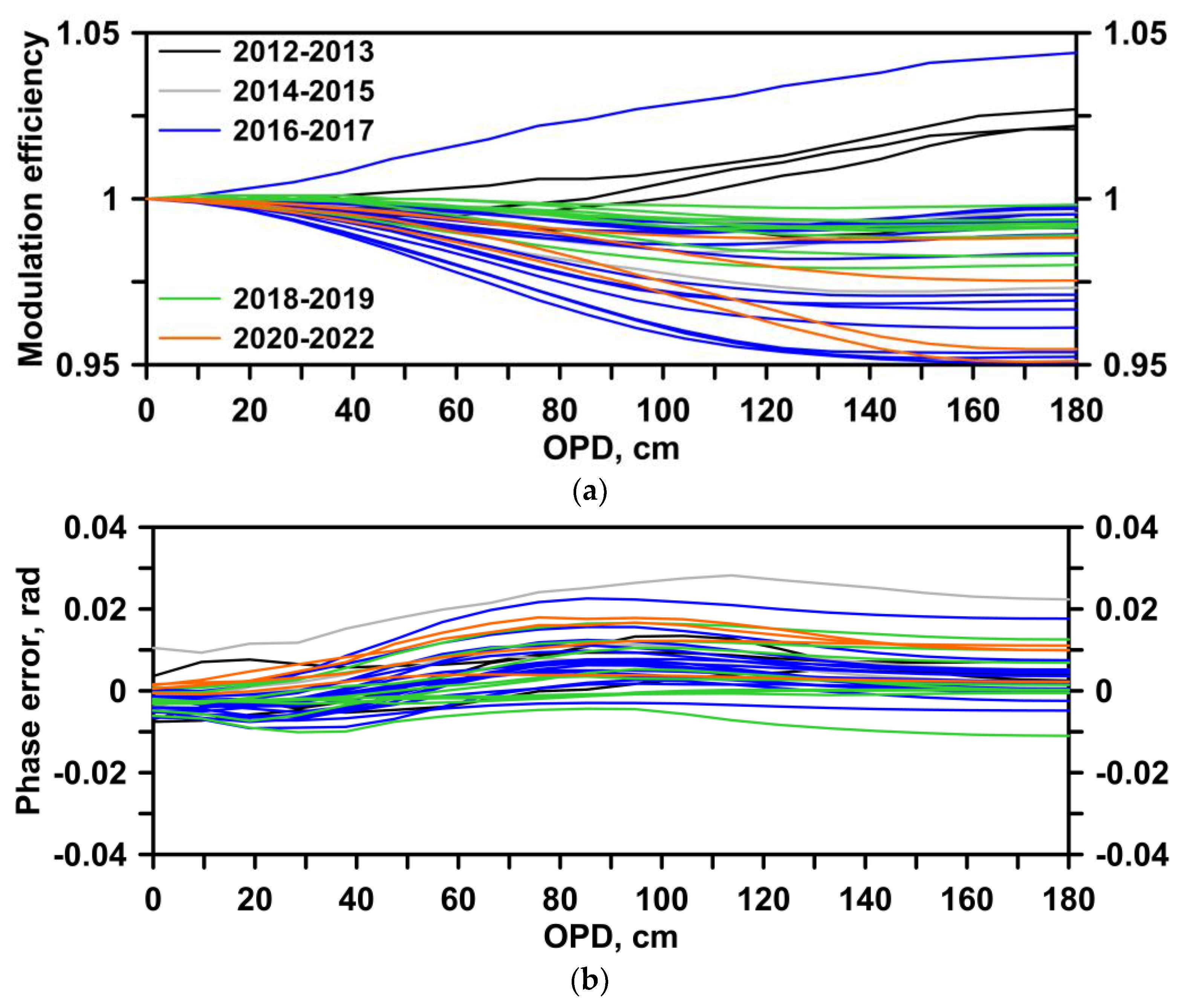
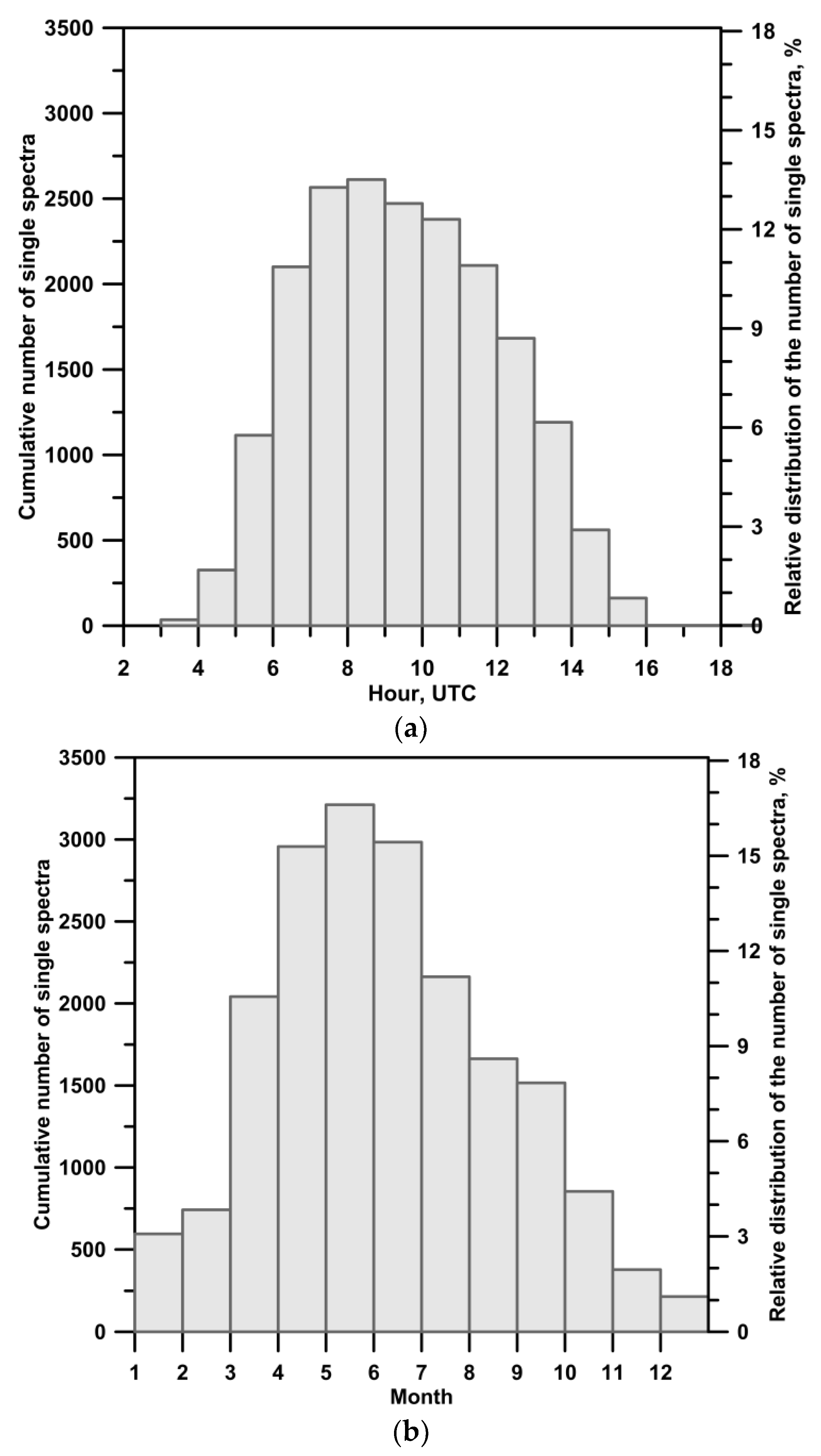

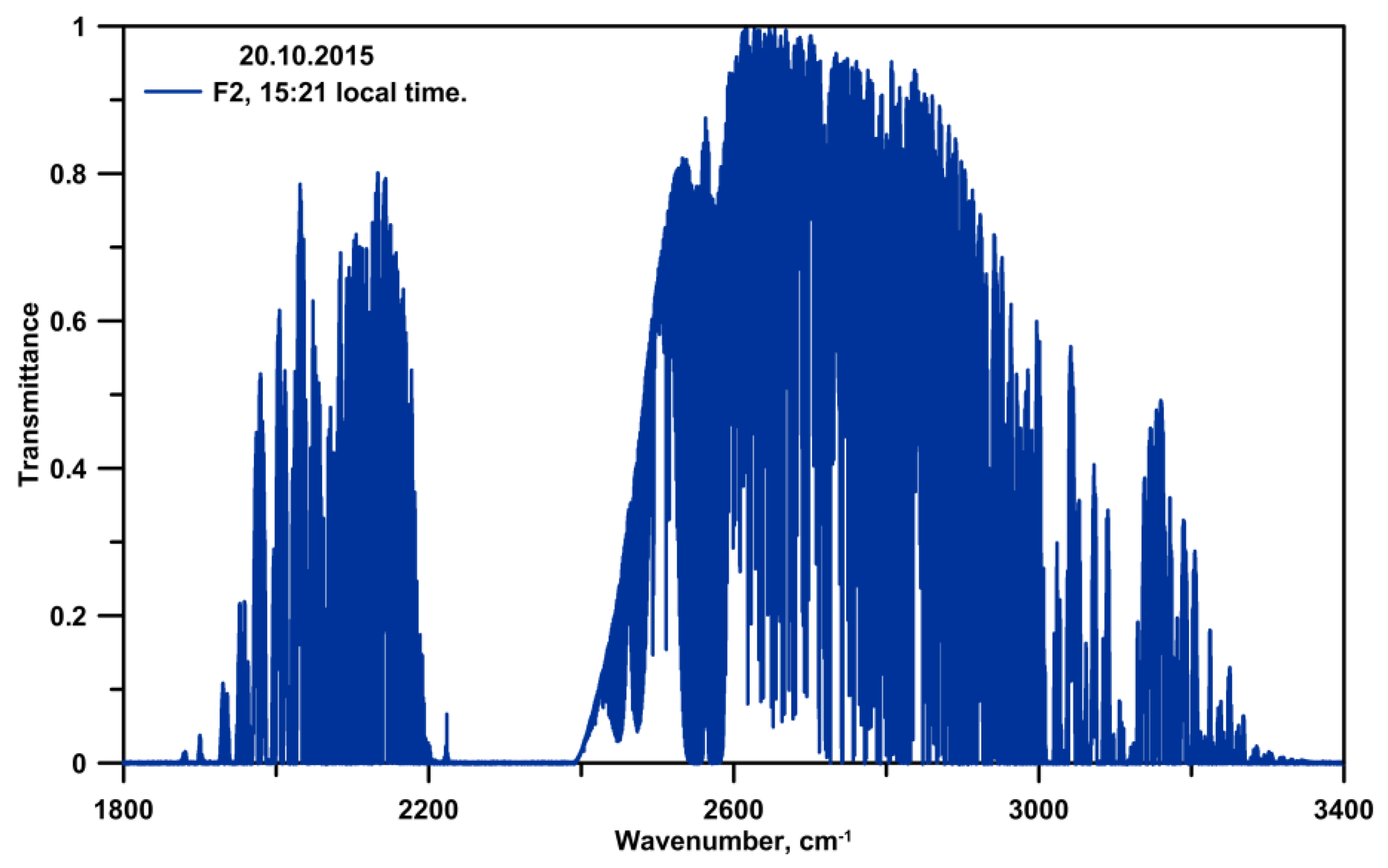
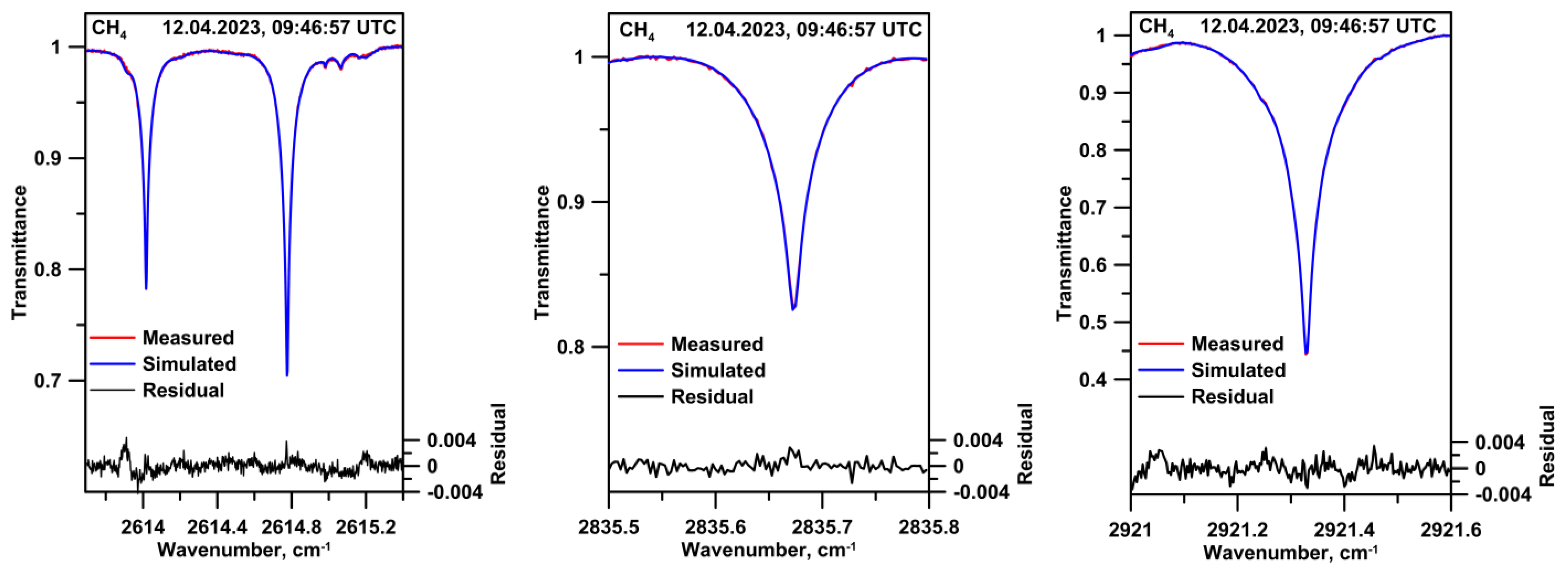
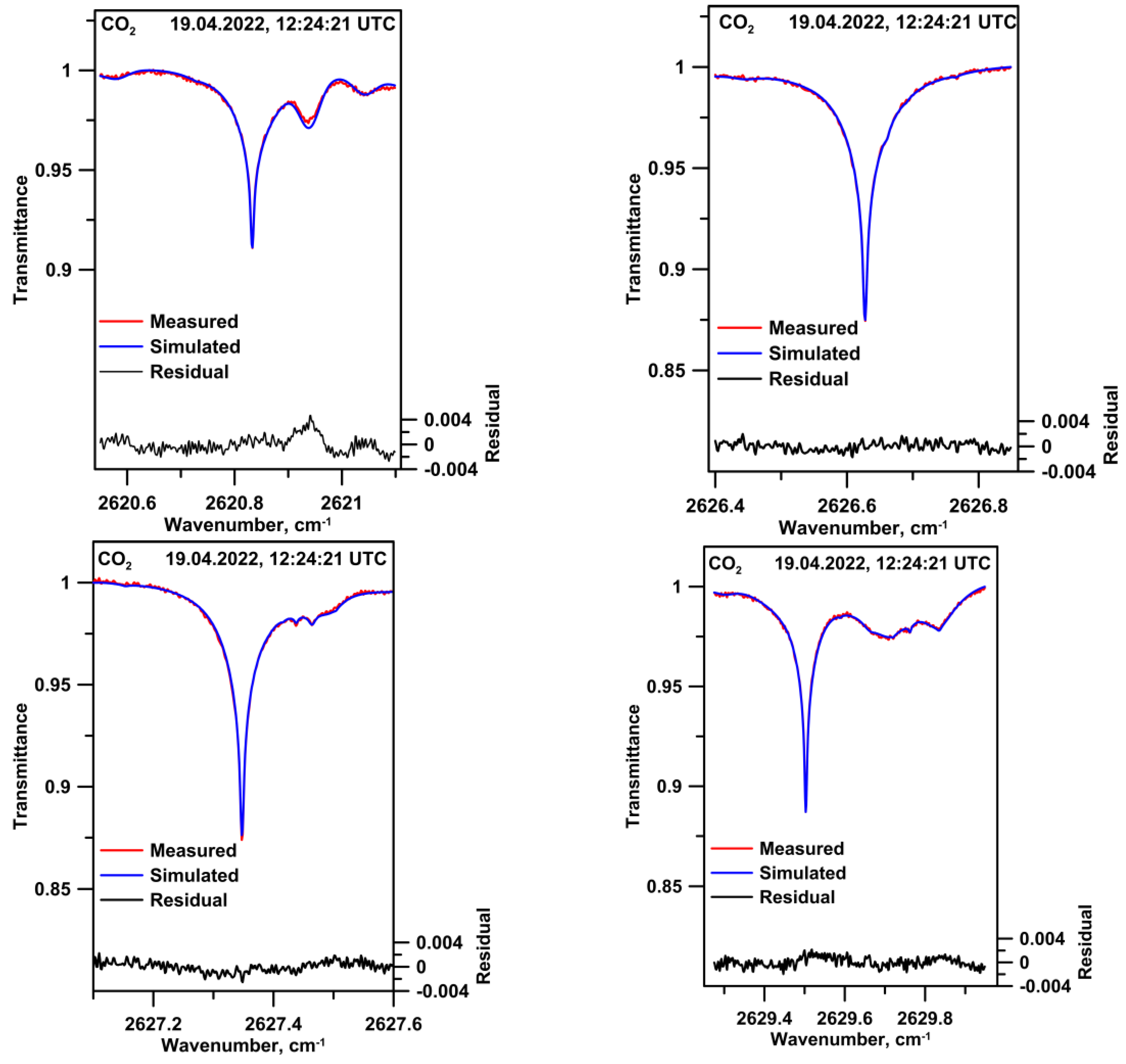

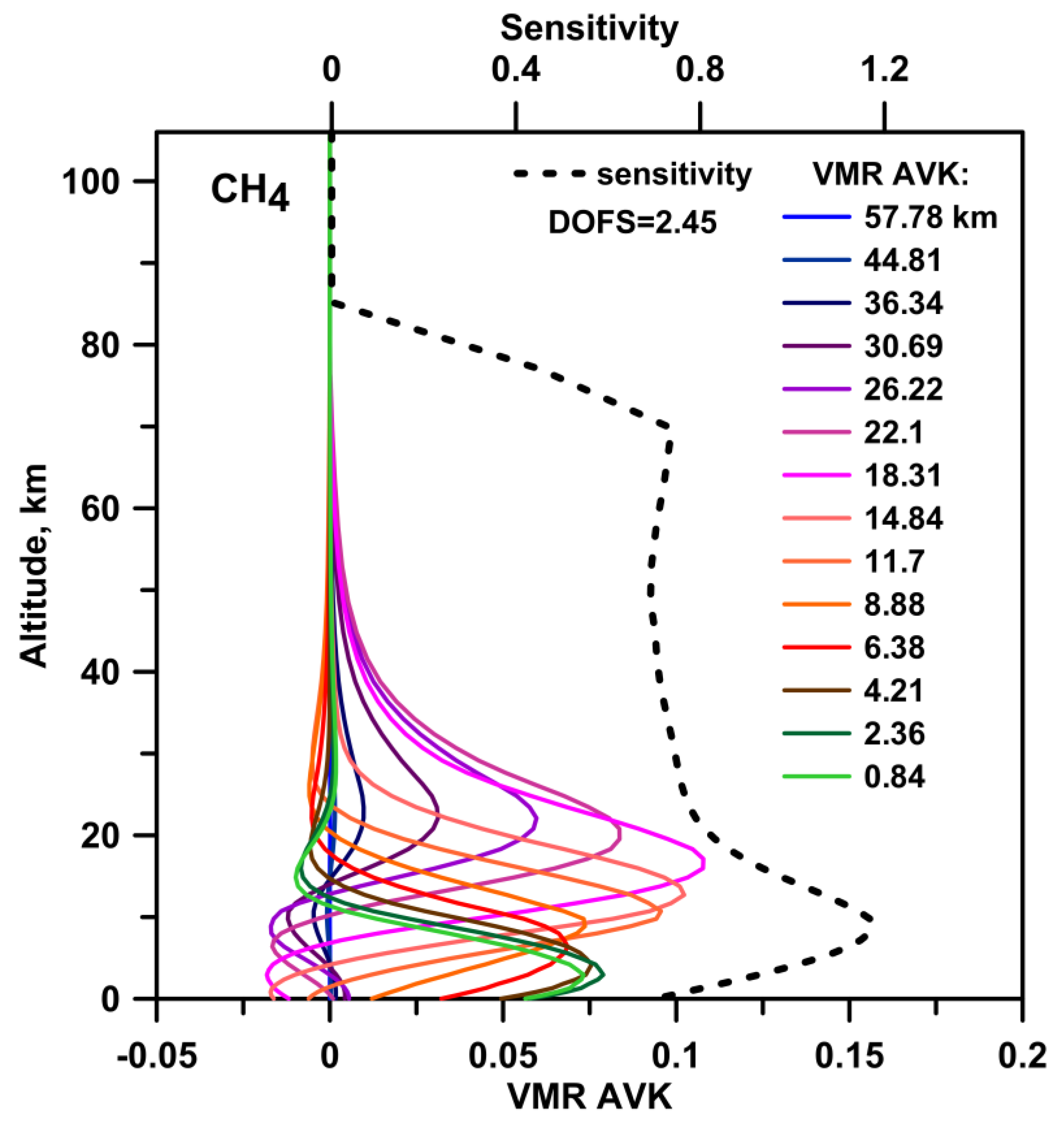
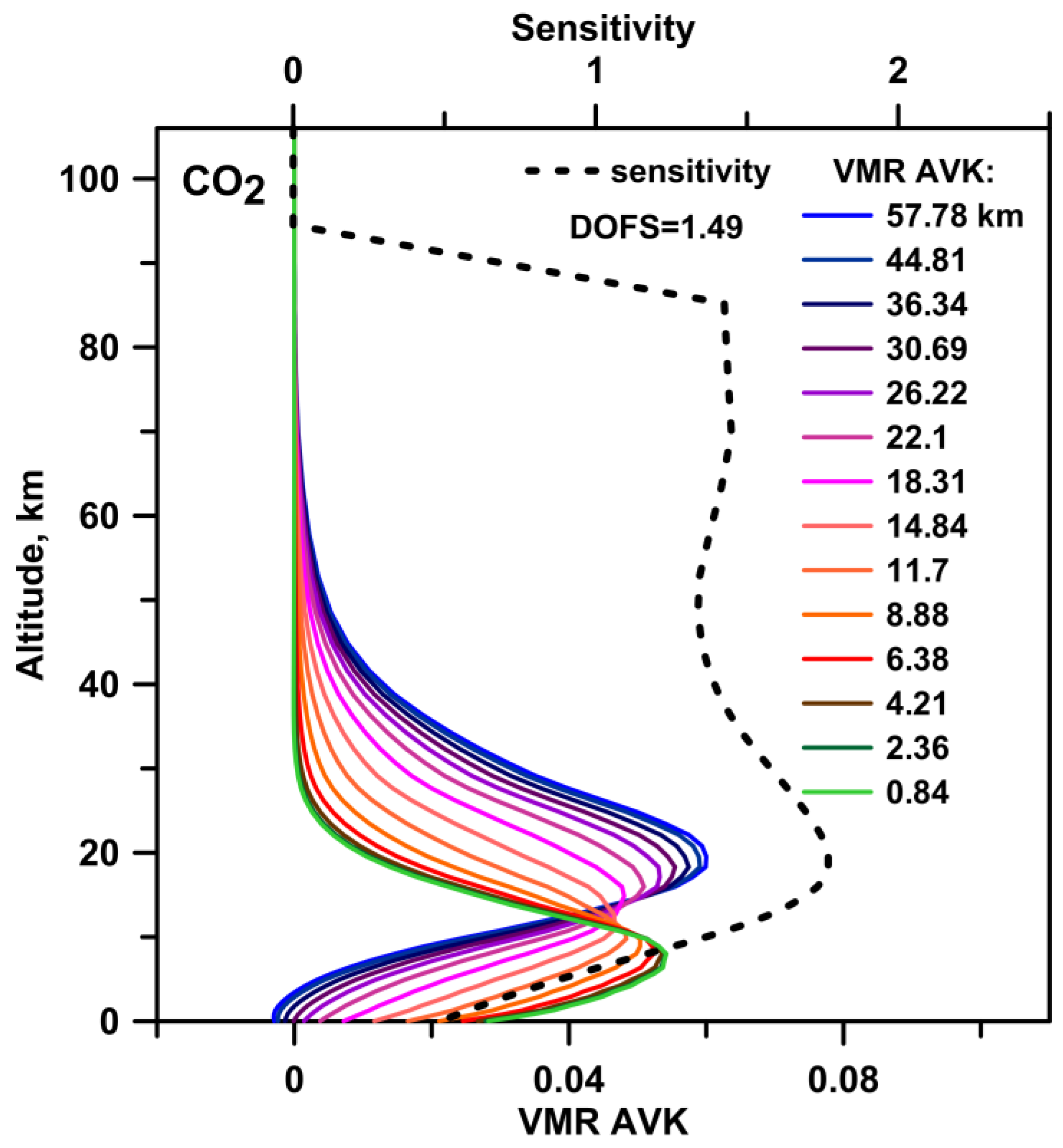

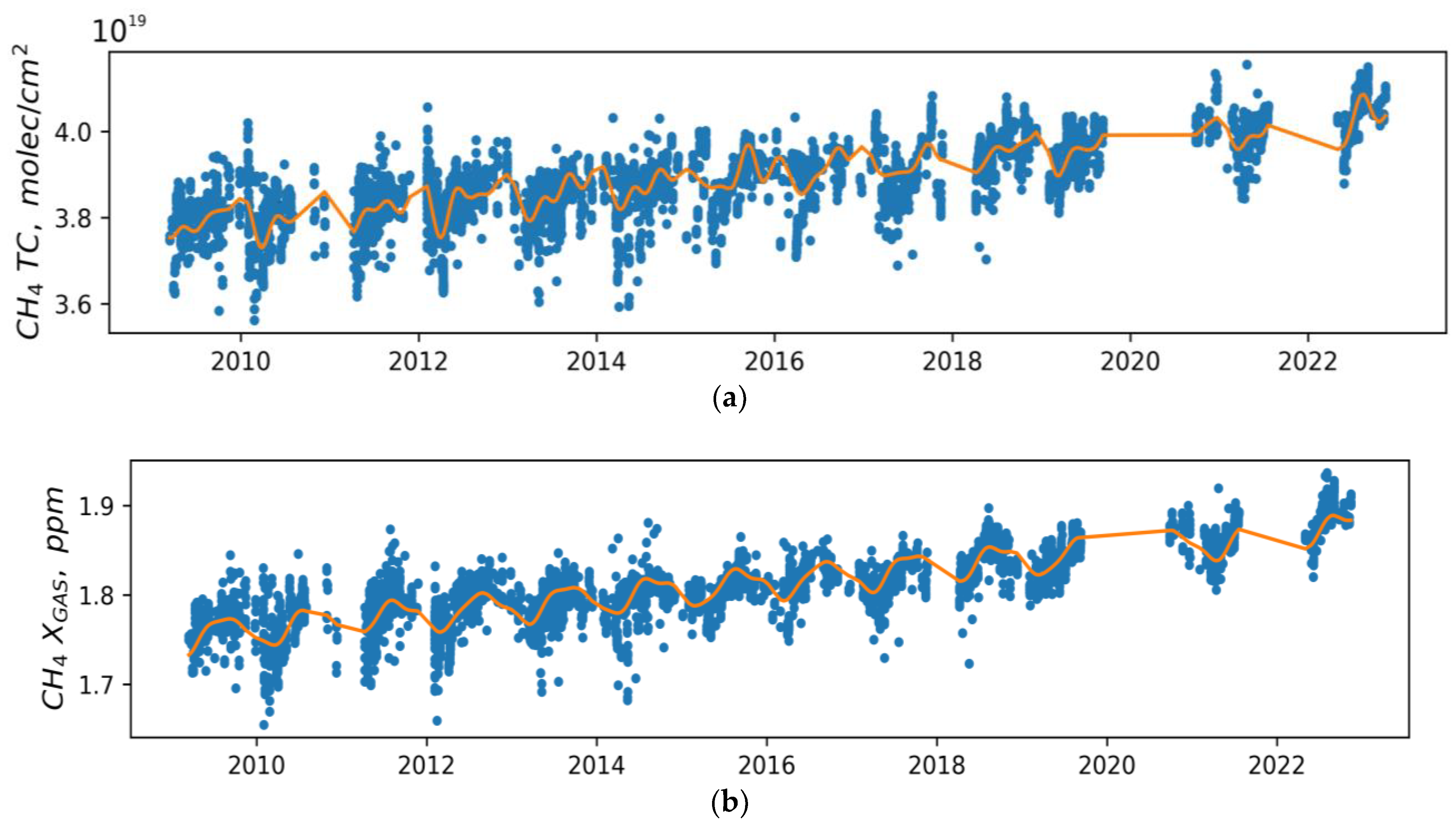



| Chemical Formula and Name | Importance | Atmospheric Lifetime | Main Global Sources and Sinks |
|---|---|---|---|
| CH4, methane | Long-lived GHG, responsible for 16% of the radiative forcing, Global Warming Potential (100 years) GWP = 27–30 [3,16]; CH4 decay leads to the formation of tropospheric O3 and stratospheric H2O [1] | 9–12 years [1,17] | Sources: natural wetlands, agriculture and waste, fossil fuels, biomass burning [5]; 50–65% of total emissions come from human activities [3]. Sinks: chemical loss by OH oxidation, soil uptake [5] |
| CO2, carbon dioxide | Most abundant long-lived GHG, responsible for 66% of the radiative forcing, GWP = 1, [1,3,16] | Complex function of geochemical and biological processes [17], can reach hundreds of years [18] | Sources: decomposition, ocean release and respiration, fossil fuel combustion, cement production, deforestation and other land-use change (land clearing for agriculture, degradation of soils) [9,17]; ~10% of total emissions come from human activities [19]. Sinks: oceans and land ecosystems [9] |
| N2O, nitrous oxide | Long-lived GHG, responsible for 7% of the radiative forcing [1], GWP = 273 [3,16]; stratospheric ozone-depleting substance | 116 ± 9 years [6] | Sources: oceans, soils, agriculture, fossil fuel and industry, biomass burning [6]; ~43% of total emissions come from human activities [1]. Sinks: chemical destruction in the stratosphere (by reaction with light and excited oxygen atoms), soils uptake [6] |
| Detector | LN-Cooled InSb |
|---|---|
| Beamsplitter | KBr |
| Fieldstop, mm | 0.8–1.3 |
| Δν, cm−1 (OPD, cm) | 0.005 (180) |
| Registered spectral range, cm−1 | 1700–3400 (optical filter F2) |
| Number of scans | 4–10 |
| Target Gas | Spectral Intervals, cm−1 | Spectroscopic Linelist | Retrieved Interfering Gases | Regularization Type | References |
|---|---|---|---|---|---|
| CH4 * | 2613.70–2615.40 2835.50–2835.80 2921.00–2921.60 | HITRAN 2000 (with 2001 updates) | HDO, H2O, CO2, NO2 | T–P L1 | [39,43] |
| CO2 | 2620.55–2621.10 2626.40–2626.85 2627.10–2627.60 2629.275–2629.950 | HITRAN 2008, HITRAN 2009 for H2O | H2O, HDO, CH4 | T–P L1 | [44] |
| N2O * | 2481.30–2482.60 2526.40–2528.20 2537.85–2538.80 2540.10–2540.70 | HITRAN 2008 | CO2, H2O, CH4, O3 | T–P L1 | [43] |
| Target Gas | TC, molec/cm2 | XGAS, ppm | RMS, % | DOFS | Random Uncertainty, % | Systematic Uncertainty, % | Smoothing Uncertainty, % | |
|---|---|---|---|---|---|---|---|---|
| Total | Tropo | |||||||
| M ± σ | M ± σ | M ± σ | M ± σ | M ± σ | M ± σ | M ± σ | M ± σ | |
| CH4 | (3.885 ± 0.089) × 1019 | 1.807 ± 0.038 | 0.14 ± 0.03 | 2.5 ± 0.3 | 1.3 ± 0.2 | 1.5 ± 0.9 | 3.6 ± 0.1 | 0.5 ± 0.1 |
| CO2 | (8.79 ± 0.23) × 1021 | 409 ± 10 | 0.14 ± 0.03 | 1.4 ± 0.2 | 0.7 ± 0.1 | 2.2 ± 0.9 | 3.4 ± 0.2 | 0.5 ± 0.4 |
| N2O | (6.59 ± 0.12) × 1018 | 0.3071 ± 0.0055 | 0.18 ± 0.06 | 2.6 ± 0.2 | 1.6 ± 0.1 | 1.2 ± 0.2 | 2.6 ± 0.1 | 0.2 ± 0.1 |
Disclaimer/Publisher’s Note: The statements, opinions and data contained in all publications are solely those of the individual author(s) and contributor(s) and not of MDPI and/or the editor(s). MDPI and/or the editor(s) disclaim responsibility for any injury to people or property resulting from any ideas, methods, instructions or products referred to in the content. |
© 2024 by the authors. Licensee MDPI, Basel, Switzerland. This article is an open access article distributed under the terms and conditions of the Creative Commons Attribution (CC BY) license (https://creativecommons.org/licenses/by/4.0/).
Share and Cite
Makarova, M.; Poberovskii, A.; Polyakov, A.; Imkhasin, K.H.; Ionov, D.; Makarov, B.; Kostsov, V.; Foka, S.; Abakumov, E. Trends of Key Greenhouse Gases as Measured in 2009–2022 at the FTIR Station of St. Petersburg State University. Remote Sens. 2024, 16, 1996. https://doi.org/10.3390/rs16111996
Makarova M, Poberovskii A, Polyakov A, Imkhasin KH, Ionov D, Makarov B, Kostsov V, Foka S, Abakumov E. Trends of Key Greenhouse Gases as Measured in 2009–2022 at the FTIR Station of St. Petersburg State University. Remote Sensing. 2024; 16(11):1996. https://doi.org/10.3390/rs16111996
Chicago/Turabian StyleMakarova, Maria, Anatoly Poberovskii, Alexander Polyakov, Khamud H. Imkhasin, Dmitry Ionov, Boris Makarov, Vladimir Kostsov, Stefani Foka, and Evgeny Abakumov. 2024. "Trends of Key Greenhouse Gases as Measured in 2009–2022 at the FTIR Station of St. Petersburg State University" Remote Sensing 16, no. 11: 1996. https://doi.org/10.3390/rs16111996
APA StyleMakarova, M., Poberovskii, A., Polyakov, A., Imkhasin, K. H., Ionov, D., Makarov, B., Kostsov, V., Foka, S., & Abakumov, E. (2024). Trends of Key Greenhouse Gases as Measured in 2009–2022 at the FTIR Station of St. Petersburg State University. Remote Sensing, 16(11), 1996. https://doi.org/10.3390/rs16111996








